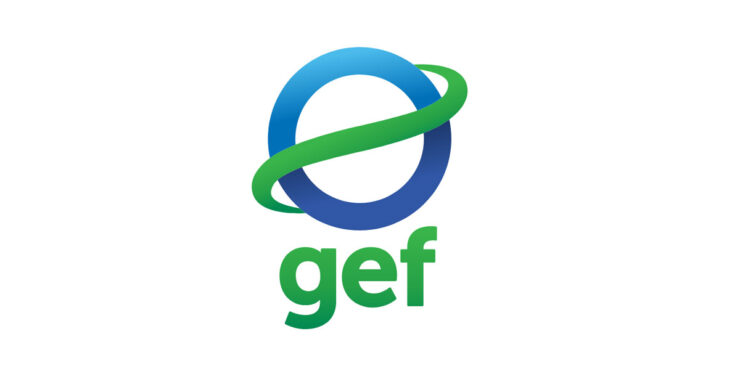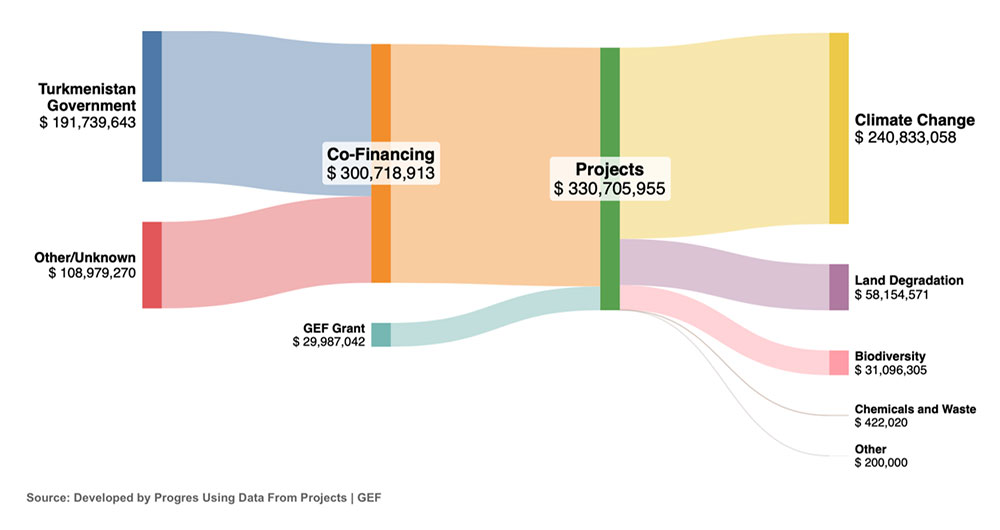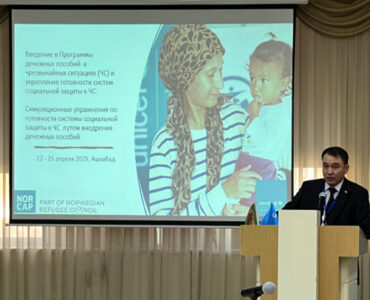How much funding does the Global Environment Facility provide to Turkmenistan and what is its impact?
Did you know that over $330 million have been spent on environmental protection in Turkmenistan since 1997? Are you aware of any project implemented in your neighborhood that tackles environmental issues? Likely, you do not, because there is limited information about how this money was used or what was the impact of these projects.
The Progres team had a closer look at Global Environment Facility project budgets and descriptions. And we have concerns about the lack of meaningful information, transparency and accountability in operations as well as whether these projects benefit the local communities.
The largest international donor supporting environmental protection in Turkmenistan is the Global Environment Facility (GEF), which has provided a total of $29,987,042 since 1997. GEF is an international organization established in 1991 that provides financial assistance to developing countries for environmental projects. It is essentially a pool of money from 40 wealthy countries that is used to fund projects such as reducing pollution, protecting biodiversity, and combating climate change in 143 developing countries including Turkmenistan. The institution publishes the amounts allocated to each country and the types of projects via their System of Transparent Allocation of Resources (STAR).
Figure 1. GEF Grants to Turkmenistan and other regional grants that include Turkmenistan overtime
As of 3 July 2024, GEF reports that 47 projects that include Turkmenistan have been either completed or are underway. These projects are implemented and executed by Food and Agriculture Organization (FAO), United Nations Development Programme (UNDP), United Nations Environment Programme (UNEP), government ministries within Turkmenistan such as the Ministry of Agriculture and Environmental Protection, Ministry of Energy and by contracting local private companies (Ynamly Kepil).
Besides benefiting from regional and global grants, Turkmenistan has received individual grants, totaling $29,987,042 since 1997. The notable projects are in Climate Change and Land Degradation focal areas, namely “Sustainable Cities: Integrated Green Urban Development in Ashgabat and Awaza”, which received $6,060,046 and “Energy Efficiency and Renewable Energy for Sustainable Water Management in Turkmenistan”, which received $6,185,000. However, none of the projects target the methane emissions within the country, although Turkmenistan’s greatest contribution to global warming is methane emissions.
Figure 2. The flow of GEF grants and co-financing by various focus areas
On top of this money, the GEF often plays a catalyst role, using their grants to attract additional funding from other sources. This additional funding, called co-financing, can come from national governments, the private sector, or other donors. Total co-financing in Turkmenistan throughout these years has amounted to $300,718,913 from various sources bringing the total funding allocated to environmental protection in Turkmenistan to $330,705,955. The government of Turkmenistan contributed almost $200 million for the projects, which accounts for 66.5% of the co-financing.
However, no data driven research was made public as a result of GEF’s engagement in Turkmenistan. There is limited information on project evaluation to demonstrate the impact and effectiveness of these initiatives. The projects lack international best practices when it comes to program management such as:
- engagement of civil society organizations (CSOs), local communities, and beneficiaries;
- clear and accessible information about the project’s goals, activities, budget, and progress for all stakeholders, including the public;
- robust systems for monitoring and reporting on project progress, outcomes, and impact and disseminate to the public;
- concrete indicators to measure the project’s impact on the target beneficiaries and the local communities;
- strong financial management controls to ensure responsible use of funds.
Weak national institutions
Donate to support Turkmen analysts, researchers and writers to produce factual, constructive and progressive content in their efforts to educate the public of Turkmenistan.
SUPPORT OUR WORKThe Ministry of Environmental Protection of Turkmenistan is noted as a focal point for GEF projects. The Ministry website has a brief page on international cooperation where they list all organizations including GEF and mention that “dozens of national and regional joint projects are being implemented”. However, there is no detailed information on these projects including program evaluation showcasing effectiveness and impact of these initiatives, whether these projects are fully implemented, how the project money is being used, or how the Ministry ensures responsible management of national and international funds.
While every program has an evaluation and review documents on the projects’ pages these are done by the GEF Secretariat which has limited overview of how these projects are implemented on the ground. It would be useful if the Ministry of Environmental Protection, as an executing agency on the ground, provided project monitoring and reporting and ensured responsible management of the funds.
Failure to be efficient and effective
Meanwhile, the available information alludes to inefficiencies in setting priorities and managing the funds. For instance, the Ashgabat and Awaza project received over $57 million from the government of Turkmenistan as a co-financing. Meanwhile, the project’s documentation primarily emphasizes the installation of LEDs street lights as a key objective, bringing into question the enormous budget allocated for it. Additionally, the document of the Ashgabat and Awaza project pledges to actively engage CSOs without specifying any particular ones, acknowledging the limited number of such organizations in the country.
A mid-term evaluation by the Independent Evaluation Office by UNDP concludes that the project is “poorly designed” and that it “failed to establish effective collaboration with key stakeholders”. The evaluation suggests that the government agencies receive training in economic and financial (cost-benefit) analysis, implying poor management of the funds.
Another example that raises some concerns is the review by the GEF secretariat of Conservation and Sustainable Management of Land Resources and High Nature Value Ecosystems in the Aral Sea Basin for Multiple Benefits, calling into question the Turkmen budgeting practices:
- “Can you please confirm that the total budget of $46,000 for video conference cameras, loudspeakers and projectors ($34,200 + $6,100 + $6,000) is a cost-effective investment”.
- “The total travel costs for the project with approximately $370,000 seem to be comparably high, especially considering that not many international experts are traveling. Please justify the costs”.
Moreover, the project descriptions are very vague and lack specific details. For example, the commentary from the Scientific and Technical Advisory Panel, administered by UNEP, on Energy Efficiency and Renewable Energy for Sustainable Water Management in Turkmenistan mentions that:
- “The project appears complex and will be very hard to manage”.
- “Integrated energy efficiency-renewable energy systems are casually mentioned”.
- “Irrigation of pastures to promote grazing in low rainfall regions may not be a feasible option at all”.
Similar questions can be found in the review documents of other projects, bringing into question the cost-effectiveness of the measures. Interested readers are invited to review the publicly available documents on each project’s webpage.
Transparency, accountability, and public access to information matter because they ensure the long-term success and effectiveness of these investments. Firstly, if the public, experts and the civil society can see exactly how funds are being used they can have informed and constructive discussions about projects’ effectiveness and the best use of resources. Secondly, openness fosters trust in public institutions, encourages public participation, local ownership and a sense of responsibility for the project’s success. Lastly, when the public has access to information, they can hold authorities accountable for potential environmental damage, unsustainable practices or irresponsible use of funds. Addressing environmental challenges requires informing and engaging local communities whose lives are directly impacted by these projects and who can guarantee long-term success, ownership and sustainability once GEF funding ends.
Progres.online team will welcome the engagement and dialogue with GEF on abovementioned issues and questions.








